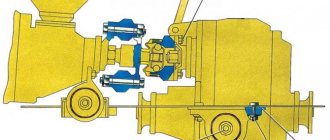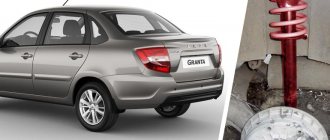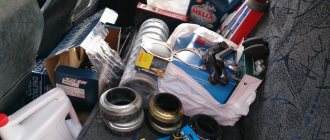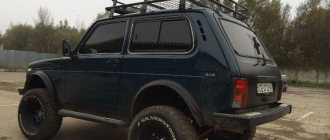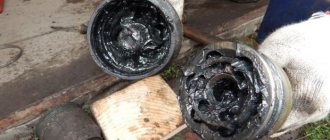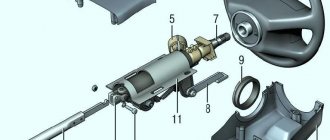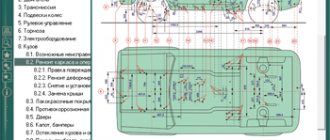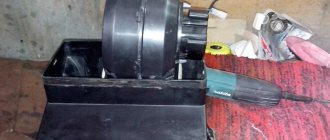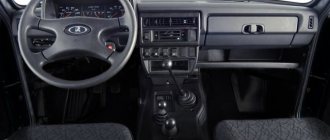What springs are suitable for Lada 4×4
When making this choice, you should take into account the dimensions of the Lada 4×4 springs. If they do not correspond to the standard ones (for example, the springs from the Chevrolet Niva are longer), then other suspension elements will have to be changed, for example, shock absorbers, spacers, etc. The result is an elevator. To minimize costs, car enthusiasts simply cut off excess coils from the springs.
What springs can be installed on Lada 4×4:
- from Chevy Niva.
- from the Volga (GAZ-24 - soft, GAZ-21 - hard), cut off 1-2 turns.
- from VAZ 21214m - medium hardness between VAZ 2121 and Chevy Niva.
- from VAZ 2104 or classics (hard, put back).
So, which springs are best to choose? They should not be too hard (when the wheel loses contact with the road or the car “bounces”) or too soft (when the body rolls heavily when cornering, “nods off” when braking, and the suspension often breaks). You need to be able to choose the right balance that will be suitable specifically for your car and its operating conditions. For example, when installing a heavier engine (diesel), the springs should also be stiffer.
What springs did you choose for your SUV? What features did you notice during their operation? Leave feedback and take part in the survey.
Assembly
Assembly of suspension units is carried out in the reverse order of disassembly. When assembling the wheel hub, place a layer of Litol-24 lubricant in the bearing separators and apply it evenly into the cavity of the steering knuckle between the bearings in the amount of 40 g per fist.
When installing crossbar extensions, tighten the inner nut until the gap between the washer and bracket 3 is selected (Fig. 4-6), and the outer nut with the torque specified in Appendix 1.
To prevent improper distribution of forces in rubber-metal joints, tighten the nuts of the lever axles under a static vehicle load of 3140 N (320 kgf). Then check and adjust the wheel alignment and toe angles.
When to change?
Let me refer to quotes from the forums: look at how your lower control arm is relative to the ground, measure the distance from the edge of the wheel to the arch, and the like. Of course, there is some truth in all this, BUT these are all consequences. We need to look at the reason, that is, at the spring itself. The next legitimate question is: where to look? The photo shows springs from the same car, one side before replacing the springs, the other after.
For some reason I remembered the magazine “Murzilka” with pictures on the topic, find 10 differences)). Red circles indicate where to look. Why do springs in this condition need to be changed and why is this criminal? Different alloys have different physical characteristics. In particular, spring steels do not withstand shock loads at all. When the coils of the springs close to full contact, an impact occurs. Stress tends to accumulate, and at some point the spring bursts. If this happens at low speed, the face of the car will simply fall down. The fuse will be the shock absorber, which will bend, and if the swing was stronger, then the body will lie on the wheel. It is much worse if this happens at speed or somewhere on the descent from a hill. I saw a short video from the Ladoga Trophy, when a short Niva drives down a hill, bounces a little and turns over. What can be seen in the slow motion replay: when flying up, the suspension dissolves. Then, the face of the car goes down, the spring bursts, the body falls on the wheel... and the car does a somersault through this wheel, since the kinetic energy has not gone away.
DIY replacement
Tools and materials
To carry out the replacement work, you will need the following tools and materials:
- Set of wrenches.
- Jacks and stops.
- New set of springs.
Work progress
Replacement of the front elements should be carried out in this order:
1. Jack up the SUV and remove the wheel. Set the stop. 2. Unscrew the nut securing the lower arm axle using an open-end wrench.
The process for replacing rear springs is as follows:
1. You need to disconnect the lower shock absorber hinge from the rear axle and move it to the side.
The entire replacement process takes no more than an hour for one wheel.
Complete video instructions for replacing jet rods on a Shnivy
The work is carried out on an overpass or inspection ditch. To replace jet rods you need to prepare:
- hammer;
- a pair of spanners 19;
- metal brush for cleaning threads;
- mounting blade;
- WD-40 liquid.
Work order:
- Clean threaded connections with a wire brush and spray with WD-40.
- Unscrew the lower mounting nut and move the shock absorber to the side so that it does not obstruct access to the transverse link nut.
- Unscrew the threaded connections holding the silent blocks and remove the transverse rod.
- Install a new rod and screw it on the top side.
- Align the holes in the silent block and the bracket, insert the bolt and tighten the nut.
- Unscrew the fasteners, remove the front rod and replace it with a new one.
- Repeat the previous step for the remaining front and two rear links.
If the rods have not rusted or bent, or cracks have not appeared on them in the area of the welds, you can only get by by replacing the rubber-metal bushings. In this case, you can save on buying new rods and get by only with silent blocks.
The pressing device is a metal rod, the thickness of which is slightly less than the inner diameter of the rubber part of the silent block.
There is a thickening on the rod that presses on the rubber bushing. The diameter of the thickening must correspond to the outer diameter of the silent block.
Replacement of bushings is carried out on removed rods.
Before installing a new silent block, it is necessary to clean the inner surface of the eyelet and lubricate it with a solution of soap or detergent. Oil, which is recommended for use in some assembly instructions, will shorten the life of rubber bushings.
After this, all that remains is to insert the pressing device into the rubber bushing of the hinge, lean it against the eye of the rod and compress the structure in a vice.
The metal sleeve is pressed in with the same device. To facilitate installation, it must be treated with a soap solution.
Rear shock absorbers for Niva 2121, 21214
The rear shock absorbers on both generations of Niva also do not differ from the installation side, and have the same serial number. As is the case with the front ones, the rear struts of the VAZ 2121 are slightly smaller than the shock absorbers of the Niva 21214. And they are also interchangeable. As for quality, the problem is still the same - uncomfortable driving on off-road and uneven roads. The dimensions of original spare parts are shown in the table.
| vendor code | Rod diameter, mm | Case diameter, mm | Body height (excluding stem), mm | Rod stroke, mm | price, rub. |
| Dimensions of rear shock absorbers for Niva VAZ 2121 | |||||
| 21212915402 | 12 | 41 | 310 | 182 | 600 |
| Dimensions of rear shock absorbers for Niva VAZ 21214 | |||||
| 21214291500400 | 12.5 | 45 | 315 | 198 | 1000 |
SAAZ 21212915402
SAAZ 21214291500400
Also, some drivers install original front shock absorbers from UAZs on the rear wheels of Nivs. This solution is most effective if the car is operated in severe frosts (from -30 to -45 degrees Celsius). In other cases, it will be more effective to install analogues.
Analogues of rear shock absorbers for Niva 4×4
The popularity of various replacements for the rear struts of the Lada Niva is similar to that for the front struts. Analogues also, although different, are interchangeable. The table below shows the most popular ones.
| Manufacturer | vendor code | price, rub. |
| Analogs for rear shock absorbers Niva 2121 | ||
| SS20 | SS20224 | 2600 (2 pcs.) |
| Fenox | A12175C3 | 550 |
| Alca | 842340 | 500 |
| Analogs for rear shock absorbers Niva 21214 | ||
| SS20 | SS20224 | 2600 (2 pcs.) |
| Trialli | AG01514 | 1000 |
| Hola | SH40-413G | 850 |
Which shock absorbers for Niva VAZ 2121 and 21214 are best to buy? For normal city driving and relatively smooth highways, the original spare part is sufficient. If the car will be used off-road, then it is better to install Trialli (the most popular brand among Niva owners). Or you can install racks from the Russian SS20 “Comfort” series. They are moderately tough and behave well on uneven surfaces.
Shock absorbers on Niva are changed depending on their condition.
As is correct, the original strut does not last too long - up to 50 thousand km. And when operating a car off-road and on bad roads, the period decreases depending on the intensity of their use.
How to determine spring stiffness
The manufacturer applies markings to the suspension springs that correspond to four stiffness groups:
| Group number | Load, kN (kgf) | Number of marks |
| I | 5,83..5,93 (595..605) | One risk |
| II | 5,93..6,03 (605..615) | Two risks |
| III | 6,03..6,13 (615..625) | Three risks |
| IV | 5,73..5,83 (585..595) | Four risks |
There is also a color coding for springs:
| Car make, VAZ | Spring color | Marking color | |
| Class A (standard, rigid) | Class B (soft) | ||
| Front | |||
| 2101 | Black | Green | Yellow |
| 2101 lane step | Metallic blue | Green | Yellow |
| 2108 | Black | Green | Yellow |
| 2110 | Black | Green | Yellow |
| 2108 per. step | Metallic blue | Green | Yellow |
| 2121 | Black | No markings | White |
| 1111 | Black | Green | White |
| 2112 | Black | No markings | White |
| 2123 | Black | No markings | White |
| Rear | |||
| 2101 | White | Green | Yellow |
| 2101 lane step | Metallic blue | Green | Yellow |
| 2102 | White | Blue | Red |
| 2102 lane step | Metallic blue | Green | Yellow |
| 2108 | White | Green | Yellow |
| 2108 per. step | Metallic blue | Green | Yellow |
| 21099 | White | Blue | Red |
| 2121 | White | Black | No markings |
| 2121 per. step | Metallic blue | Green | Yellow |
| 2110 | White | Black | No markings |
| 2110 per. step | Metallic blue | Green | Yellow |
| 2123 | White | Black | No markings |
| 2111 | White | Blue | Orange |
| 1111 | White | Green | No markings |
It is recommended to install springs of the same class in the front and rear suspension. In some cases, it is allowed to install class A springs forward and class B springs backward, but not vice versa. If you often have to transport heavy loads in the trunk, you can install reinforced springs (more rigid) back.
Important! They need to be selected in pairs based on stiffness for the front and rear suspension. This wish accounts for 95% of all requirements for springs
Classification
The suspension elements under consideration are divided into two types according to their rigidity:
- Standard hard ones are designated by the letter “A”. They have high stability and load capacity.
- Soft “B” is their main advantage in providing increased comfort, but at the same time they quickly become unusable - they “sag”.
Reference! From the factory, Shniva is equipped with class “A” parts, that is, rigid ones.
Types of springs for Chevy Niva
The time comes when the springs on a Chevrolet Niva need to be replaced. First you need to figure out which suspension elements are best to install so that they provide the expected properties.
Front
You can replace the front suspension elements with devices from manufacturers such as Izh-Techno, Kilen, Lesjofors, Reid or Techno Ressor.
It is necessary to mark only devices of the Reid brand, the cost of which is 4,000 rubles per set. This price is due to the high quality of the kit.
Rear
Unlike the front end, it is recommended to install reinforced elements on the rear part. This is necessary so that the SUV can be loaded, and at the same time the car still absorbs shock from the road well.
Spacers
In this case, one main condition must be met - the absence of signs of deformation. Spacers help restore the functionality of the shock-absorbing elements of the suspension, thereby the owner can save money.
Purpose
The spring is located in the gap between the frame and the wheel, thereby allowing the wheel to move up/down freely. This important part absorbs shock from the road, thereby allowing the wheel to continue moving.
Springs on the Chevrolet Niva are installed both front and rear. The rear springs perform a similar role to the front ones. Often the rear springs are strengthened or spacers are added to raise the rear end as high as possible. Thanks to these elements, shock from the road is absorbed.
The Chevrolet Niva is equipped with steel springs, so we will consider them. These elements have a steel construction with coils. The product is not particularly complex in design and is often used in all cars. Without these elements, driving a car is possible, but in this case the body will be less rigid.
Why do you need spacers for springs?
Over time, the standard set tends to sag, thereby losing rigidity, elasticity and functionality. To correct the situation, a replacement will be required, but not in all cases. So, if the product had the property of sagging, but without deformation, then you can do without replacement. For this purpose, there are special spacers that, in addition to restoring functionality, increase the vehicle's ground clearance. In this case, by installing spacers, you can save a lot on finances. If the product has mechanical damage, the spacers will no longer save you and will need to be replaced.
This is what spacers look like
Spacers are available in various designs:
- Spacers between the spring support and the body element cup. Often this type is applicable for MacPherson-type suspensions, when when turning the strut rotates with a shock absorber.
- Interturn spacers are the simplest in design and installation. Can be installed on both rear and front springs. They do not have the ability to change ground clearance, but noticeably change the elasticity of the product.
- Spacers between the spring and the body bowl are the most common option, as they combine two functional features: increasing ground clearance and adding suspension stiffness. Standard and reinforced spacers are available. Standard spacers are designed to slightly increase ground clearance, while reinforced ones differ from the first ones in the height of the structure. The difference in height is 30 mm, which indicates a significant increase in ground clearance. Reinforced types of spacers for rear springs are especially popular.
Spring options for Shevik
- Izh-Techno are an excellent solution for replacing standard models. The cost of the kit is 2800-3200 rubles, but the service life of these models is much longer. For the Chevrolet Niva, the Izh-Techno +1 spring is recommended. The domestic auto industry has something to boast about, so if you don’t want to overpay, then it’s better to install the Izh-Techno kit.
- Kilen. These products are produced in Sweden, which already indicates their high cost. So, one element costs about 1000-1200 rubles. The thickness of the coils of this product is 14 mm for the front and 14.9 mm for the rear. For comparison: for standard products the size of the coils is smaller and is 13 mm.
- Lesjofors. A practical analogue of Kilen, which even have the same numbers.
- Raid. Currently they occupy a leading position, so we will tell you more about them.
Springs for Niva Chevrolet "Raid"
"Raid" is produced at one of the Russian enterprises, which is called CJSC "PPRZ". These springs have a long history, but we won’t dwell on it, it’s only worth noting that Reid is one of the most successful solutions for reinforced products for the Chevrolet Niva.
Three enterprises take part in the production of Reid springs: winding is carried out on special US equipment, painting is carried out by the ITW GEMA AG complex from Switzerland, and a Russian company is engaged in production. Each Reid spring undergoes a thorough check and only after that it reaches the shelves of car dealerships.
The main feature of Raid products is that after their installation, the car on the road becomes completely unrecognizable. If previously each hole was felt by the entire suspension and transmitted to the body, now all impacts are absorbed in the initial stages.
Springs on the field, theory
There is a complete mess going on on forums and in people’s heads regarding the selection of springs. I won't dwell on factory springs for a long time, I'll just say one thing. My friend bought himself a Niva Urban Crocodile in 2022. The lower coils of the front springs closed at 20 thousand and the standard wheels began to bite the locker. Now one rhetorical question for fans of factory springs: it is known all over the world that the best quality goes to the assembly line, and everything else goes to the spare parts market. If conveyor springs are of such quality, then what do they offer you with all sorts of different stripes? Among the branded springs, another manufacturer has appeared on the market - Kayaba. All their adult lives, the guys made shock absorbers, and then they took up springs... and failed. They decided not to increase their production, but placed orders from a third-party manufacturer. Quality floats like a violet in an ice hole. At one of the technical seminars held in St. Petersburg, Kayaba representatives avoided questions about springs as best they could and emphasized in every possible way that these are different units and there is no need to equate them.
Now for the “Swedes”. There is complete obscurantism going on on the forums and the drive of numbers and articles. They say there are springs for M-ki, there are already 006 springs for urban and other fabrications. Meanwhile, just look at the official Kilen-Lesjofors catalog for everything to fall into place. The manufacturer offers springs for the field in four articles. 4047001 – front springs for a short wheelbase (three-door), 4047006 – front springs for a long wheelbase, 4247002 – conventional rear springs, 4247010 – reinforced rear springs. All! There are no other options
I do not take into account the Kilen numbers, since the essence and springs will be the same
